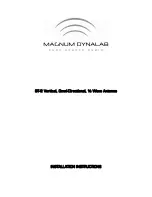
MFJ
Super Hi-Q Loop
Antenna Instruction Manual
1
MFJ
Super Hi-Q Loop
Antenna
CAUTION: Do Not Attempt Operation Of This Unit Before Reading All Instructions
The MFJ "Super Hi-Q Loop" is the best performing and most convenient small space antenna available
to amateurs today. The MFJ-1786 covers 10 MHz to 30 MHz. The MFJ-1788 covers 7 MHz to 21
MHz. The antenna is only 36 inches in diameter and features an indoor semi-automatic tuning unit with
a built-in cross needle wattmeter. All tuning and control voltages are coupled to the antenna through
the coaxial feedline for simple, neat, one wire installation.
The loop antenna element is constructed from thick walled aluminum pipe. Every current carrying
joint is welded to eliminate high resistance pressure contacts that reduce efficiency. The loop element
is tuned with a low-resistance, high current, variable capacitor. The outdoor electrical and mechanical
components are protected by an attractive weather resistant molded cover.
WARNING! Never mount this, or any other antenna near power lines or utility wires! Any
materials: ladders, ropes, or feedlines, that contact power lines can conduct
voltages that kill. Never trust insulation to protect you. Stay away from all power
lines.
THEORY OF OPERATION
When resistive losses in a small loop antenna are kept low, a small loop antenna will transmit nearly as
well as a full size dipole. MFJ was able to make this small loop antenna radiate nearly as well as a full
size dipole by paying special attention to the electrical and mechanical construction of this antenna.
Because radio frequency currents primarily flow near the thin, outer edges of flat conductor loops, flat
conductor loops will have much higher RF losses. To avoid this problem the MFJ "Super Hi-Q Loop"
uses a thick wall, large diameter, round aluminum pipe for the radiating element. This construction
method results in much better performance since the RF losses in the round, large diameter pipe are
many times lower than the losses in a flat conductor.
MFJ forms the large diameter aluminum pipe into a circle on special machines and heli-arc welds all
joints to eliminate resistive pressure connections in the antenna. A specially constructed butterfly
capacitor using arc-welded construction has much lower loss resistance than conventional, less
expensive, pressure contact, air variable capacitors.
The care and expense used in selecting the best materials, not the most convenient materials, has
resulted in an extremely efficient small size antenna. Extensive "on the air" tests have confirmed that
most stations can detect little difference between the signal from the MFJ "Super Hi-Q Loop" and the
signal from a full size dipole at the same height.
































